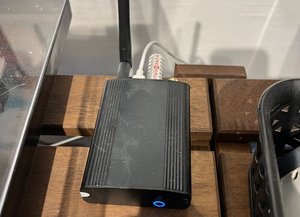Dette er gøy, og helt i temaet. Rainer Mailard (Emil Berliner Studios) om produksjonen av Karajans digitale innspillinger av Bruckners symfonier nr. 1-3 for utgivelse i den til nå helanaloge Deutsche Grammophon The Original Source-serien. Mine uthevninger:
Karajan had to have digital multitrack productions right from the start (1979)*, and he and his team became caught up in the idea of progress to the exclusion of everything else. Even though they could have used a Sony PCM 1600, which was a much better-sounding recorder than the 3M, it could only accommodate 2 tracks. For Karajan, abandoning multitrack technology and going back to stereophonic, 2-track recording of any kind - be it analogue or digital - was not, and could never be, an option.
As a result, Symphonies 1-3, produced with the supposedly superior digital technology, lag behind the earlier all-analogue recordings sonically, because digital artifacts, when they occur, are perceived as more disturbing than analogue artifacts.
The sound quality of the analogue-to-digital-to-analogue conversion in particular was a shortcoming of the old 3M machines. In fact, in the 1990s DG started to equip its 3M machines with digital interfaces in order to be able to carry out the digital-to-analogue conversion with newer and better converters. However, the 3M machine at the time of Karajan’s digital Bruckner recordings - a decade earlier - worked with a sampling rate of 50 kHz, which is no longer used today. For the present release, the tapes were transferred to a workstation and upsampled to 96 kHz. Most of the digital artifacts from the AD conversion were then removed using new digital tools. Here, digital technology definitely offers advantages over a purely analogue workflow (although removing digital artifacts is not even necessary with analogue multitrack tapes). After doing this we found the sound had already been greatly improved, but it still had an unpleasant quality to it. This was due to the primitive analogue-to-digital conversion of the 3M machines.
In order to further ameliorate the harsh sound of the original analogue-to-digital conversion, Emil Berliner Studios took the unusual approach of deliberately using a tube-based mixing console from 1960. (Incidentally, this was the same console which Herbert von Karajan and his production team used to produce his legendary Beethoven symphony cycle in the early 1960s).
The summing on this console is passive. This functional principle, which guarantees a particularly clear sound, was also the model for the modern passive mixing consoles we designed specifically for the OSS project. However, unlike our current consoles, that 1960 vintage mixing console had a tube stage at both the input and output stages. These were driven relatively "hot", which leads to unavoidable overtones. And it is precisely this effect - actually known as the distortion factor - that is often referred to as the "tube sound”, and it behaves differently with tubes than with transistors.
We also deliberately used passive filters constructed according to this principle in tube technology. These filters likewise "color" the sound of the mix, adding an "analogue" quality. This was all done with the aim of caressing the ear with "analogue colorations”, thus providing a counterbalance to the digital artifacts that might otherwise give a certain cold, harsh quality to the sound.
Herbert von Karajan's sound engineer, Günter Hermanns, originally added a slight amount of reverberation to the recordings by using a very early digital reverberation system. This was necessary because, with the digital recordings, he hadn’t used room microphones to capture ambient sound (something he had done with his earlier analogue recordings). To replicate this reverb today we used a much better sounding, purely analogue echo chamber that produces a very balanced and pleasant reverb.
Tube based mixer from 1960, used to record Karajan's 1962/63 Beethoven Symphony cycle, and pressed into service for the remixing of his digital Bruckner recordings (Photo: EBS)
*Mitt tillegg.
Kilde.









